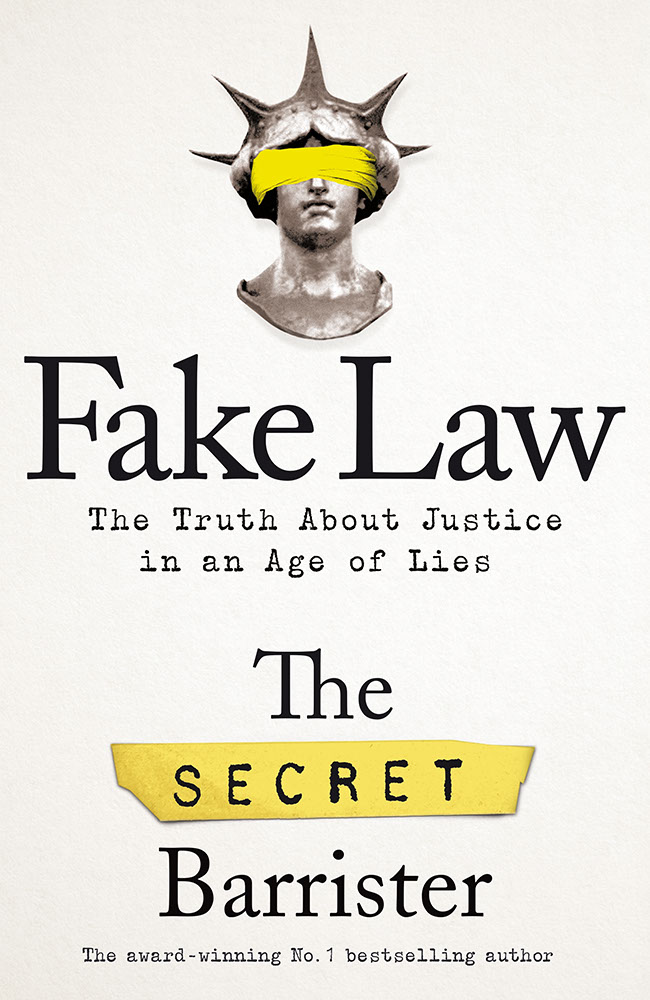Fake Law: The Truth About Justice in an Age of Lies by the Secret Barrister

Reviewed by Catherine Gleeson
The Secret Barrister (SB) is an anonymous blogger and a junior barrister specialising in criminal law in the courts of England and Wales. His first book was a personal account of the many failings of the English criminal justice system. This, his second book, is about the misrepresentation of the law and legal cases by politicians and the media. The SB writes from a land in which three justices of the High Court found themselves splashed across the front page of the daily mail and branded enemies of the people for ruling on the role of the parliament in triggering Britain’s exit from the European Union.
We have seen this phenomenon closer to home, from occasional Murdochian judge bashing to the Australian and AFR and Justinian treating legal developments as if they belong on the gossip pages, to the Rule of Law™ doing some herculean and highly inaccurate lifting to protect a cabinet minister from an examination of his fitness for office.
The SB contends that the public misunderstanding of the law that allows legal issues to be distorted in this way is largely the fault of the law itself: accessing the correct law is complex and frequently out of date or incomplete, most Britons do not receive adequate basic instruction in how the law works and what its practitioners do, and lawyers themselves do nothing to share their secrets: 'while the social-media age has brought forth a generation of writers, bloggers and tweeters doing their best to kick down the doors to the courtroom and shine a torch on the arcane activity outside, our historically well-earned reputation as the keepers of the keys, cloaked in black and speaking in tongues, means that many citizens feel irredeemably disconnected from the legal system and its players.' This is dangerous not only because a disengaged public lack faith in the legal system, but because they lack the tools to properly diagnose the flaws in the system and articulate arguments for reform. It is easy for the gaps in understanding to be exploited by those who stand to gain from misunderstanding of legal rights and protections, and easier still for the most vulnerable to suffer from that exploitation.
In this book the SB identifies some of the major public legal controversies and explains the legal principles that apply to them, so that inaccuracies can be identified and the real problems diagnosed.
In each chapter, the SB examines a single legal issue that garners public attention. He starts by explaining the law of self-defence as it relates to numerous cases of home invasions in which the homeowner was prosecuted, and in the course of doing so identifies unreported facts that led juries to conclude that the defence was not engaged in those cases. He then goes on to explain how the misreporting led the Conservative party to seek to legislate so as to excuse the use of disproportionate force in home invasions, which fortunately for all involved they failed to effectively do.
The same treatment is given to a number of issues: the tragic cases of two babies terminally ill with mitochondrial disorder and their parents’ desperate fight with the hospitals who applied to the court for orders regarding the continuation of their treatment; the sustained narrative of out-of-control compensation culture used as a stalking horse by insurers and employers' groups to impose prohibitive caps on motor accident damages and restrictions on workplace remedies; the Conservative Government’s Euroskeptically fraught relationship with the Human Rights Act 1998 and the devastating effect it has had on Legal Aid and access to justice; and the many lies and misconceptions that beset public perceptions of criminal law, such as 'an acquittal is proof of innocence' and that certain accused are less deserving of legal representation than others.
One of the most interesting chapters concerns what happens when the so-called 'court of public opinion' comes up against the rule of law in difficult cases involving unpopular individuals. Unlike the unusual spin being indulged in by our present government, the traditional course was described as follows as applied to whether an architect of the global financial crisis should get to keep his contractually mandated pension: 'Ms Harman correctly calculated that this base appeal to our worst instincts would play far better than a sober and reasoned explanation of the importance of equal treatment under the law, no doubt because she had seen how successfully her forebears and contemporaries had navigated difficult legal cases by casually tossing the rule of law under the bus.' The SB examines a number of examples of the Government’s temptation to engage in ad hominem treatment of various individuals, from the murderers of James Bulger to Sir Philip Green’s Weinstein moment to Shamima Begum and her child.
Fake Law is a funny book and an interesting book. In keeping with the author’s intention, it explains fundamental legal concepts in a way that is easy to understand and discusses them in a way that will engage lawyers and non-lawyers. The book finishes by offering elegant solutions to the problems the SB has identified: simpler and fairer reporting of issues and better public legal education, for children and for those professions to which an understanding of the law is essential, including journalism and public service.
Fake Law is an excellent book for those of us who are endlessly frustrated by the tendency of politicians and the media to convince the public that fewer rights and less justice is the better way, and are looking for a means of articulating why this needs to stop and how to stop it.